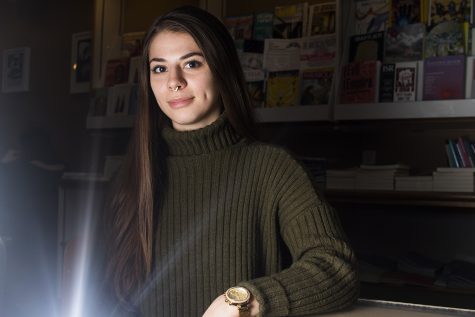Getting inked, from building needles to now
Iowa City offers a plethora of tattoo talent. But this business boom is relatively recent, as cultural norms and tools of the trade changed drastically in the past decade or two.
University of Iowa student, Nick May poses for a portrait with his tattoo sleeve on Monday, January 14th, 2019.
January 16, 2019
The tangerine room of the Velvet Lotus tattoo shop on the evening of Jan. 10 was lined with an expanse of diverse artwork, the air crisp with the scent of alcohol and ink. Michelle Balhan, the owner of the shop, threw on her silver glitter apron over her sweater, filled her plastic cups with bright inks, and diligently prepared her station before taking a seat on her stool and going to work in a craft she has honed for the past 23 years.
Balhan bent over the sleeve of her regular client, kind eyes laser-focused on filling in the bright yellow of a flower, the buzz of her needle mingling with the sounds of Michael Jackson playing over the speakers.
“I’ve heard stories of clients being very intimidated by tattoo artists,” she said, wiping excess ink off the arm of her client. “Once you have that personal [connection], have had conversations with them, you feel comfortable letting them into your space. It’s not always easy letting someone be so close to you, let alone with a tattooing needle.”
The art of tattooing and body modification has boomed in the past decade or two; as of 2017, 4 in 10 adults reported having at least one tattoo, according to a Statista survey. While tattoos have been around since as early as 2000 BCE, until recently, they have only been associated with high-risk groups and delinquency, according to a 2018 report from the American Academy of Pediatrics.
With everyone from top celebrities to college freshmen delving into the art of body modification, the culture and art of tattooing and piercing has changed significantly, from the tools of the trade to the cultural acceptance of it.
Jeff Betts, the owner of Iowa City Tattoo, has worked in the Iowa City area since 2005 and personally witnessed the shift in the college town.
“The biggest thing in the past five to 10 years is that people are getting tattooed on a regular basis, people are getting tattooed, and it’s not a big deal,” he said.
The openness and information available to customers has changed as well.
“When I started getting tattooed, there wasn’t much of an option [in design]. You told the person what you wanted, or you picked it off the wall or out of their book, and that was the end of it,” Betts said. “People are a lot more informed in general before they come into a shop now.”
He said that individuals planning to get a tattoo can sometimes spend weeks or months learning about the tattoo process and techniques before even walking into the shop, whereas before, information was a lot harder to come by.
Iowa City Tattoo is one of the shops in the area that allows walk-ins — customers can go to the shop without an appointment and, if the artist has time, can get it done that day. While Betts said some customers have specific ideas in mind, most customers take the artist’s advice.
It’s people who want to tell their stories, carry something as some memento or reminder of their life or their history.
— Nikki Powills
“Most people are pretty open and receptive to suggestions we give them, because we know more than they do, after all,” he said. “We just want to make sure they get the best tattoo they can get.”
Balhan, in contrast, operates Velvet Lotus by appointment only, so she and the artists have the time to develop the idea and get to know the client well in advance of the appointment.
“We want the client to choose the artist for the artist, and have the client educated to what can be done, and let us expand on their idea,” she said. “Each client is going to have one-on-one with the artist.”
Down the road and around the corner from Iowa City Tattoo, sheets of flash designs — tattoos that artists designed ahead of time in their own particular style and are typically smaller in size — line the walls of Temple Body Arts.
Nikki Powills, an artist at the shop, said that once customers pick a hand-drawn design from the wall, it will never be used again; every tattoo that Powills completes will be unique.
Powills has seen the shift in the type of clientele getting tattoos, changing from marks signifying toughness to unique pieces that tell someone’s story.
“Back in the day, you hear sailors and prostitutes and gangs, those are who got tattoos, but now it’s everyone,” she said. “Doctors and lawyers all tattoo. I get the fresh 18-year-olds who get tattoos. It’s people who want to tell their stories, carry something as some memento or reminder of their life or their history.”
Kyle “Kow” Bingham, the manager of Release Body Modification, the shop right across the street from Temple, has been in the piercing business for 16 years, so he has also noticed the shift in public acceptance for body modification.
“A lot of the stigmatism that used to be there with piercings, maybe 10, 15 years ago, is starting to diminish,” he said. “Even if they’re not trying to get a bunch of facial piercings, there are a lot of different things that they can do on ear piercings or other piercings that are more discreet. It’s not going to be such a surprise to an employer when you walk in.”
Along with the types of clients, the tools of the trade have changed as well; all three artists recall a time when needles had to be built by the artists, items were sterilized in shop, and machines required significant maintenance. Above all, the business was smaller and more challenging to get into.
“I didn’t think about tattooing when I was growing up, no one did. It was really hard to get into tattooing when I was younger, too. It was a really closed business,” Betts said. “It was a bunch of angry old bikers who didn’t want anybody taking money out of their pockets. You had to know somebody to get in.”
Betts said when he first started, he couldn’t get numbers for supply companies, so he had to purchase the tools he needed through his boss.
“If you needed a machine, you needed somebody who knew somebody who built machines. They didn’t want people making their money,” he said. “Most the tattoo artists back in the day couldn’t stand each other because they were competition. Now, that’s all out the window. We’re all doing business, so something’s working.”
Powills agreed with the change in the artists and the field.
“In the past 10 years, you have seen a change of it being more of this lowbrow lifestyle, rough and tough guys, into actual artists getting into it,” she said. “It’s people getting degrees in art, people who have painted and drawn their whole life, instead of just ‘we do drugs and ride motorcycles, so now it’s much more of a professional standing. People are really interested in making it an artform and not just something that older generations will scowl at.”
With seven tattoo shops in the Iowa City and Coralville area, University of Iowa students have a significant amount of choice when it comes to getting a tattoo near campus.
RELATED: Released: Iowa City suspension
UI freshman Nick May got his most recent tattoo over winter break: a tribal-style half sleeve featuring the Chicago skyline and flag.
“I loved rugby, and I grew up watching rugby with my brother, my family, and everything, and I would always see these big intimidating scary-looking guys with the tribal half sleeve,” he said. “I always wanted a tribal half sleeve, but I’m not from a tribe or an island or anything of the sorts, but I’m from Chicago.”
May said he underestimated the pain of receiving the intricate half-sleeve.
“After the first 10 minutes, I could feel the needle just dragging across my skin. It’s odd because you feel two different types of pain,” he said. “You feel the pain at the spot where the needle is hitting, but then you feel the pain to the nearest central point of nerves. I felt it on the inside of my arm, I felt it through my armpit while the needle was going. It’s more like a burning, white-hot sensation.”
Despite this, May said he thinks everyone should go through the process of getting a tattoo.
“I recommend everyone gets a tattoo, but just make sure that you’ve been thinking about it, like I’ve been thinking about this design for a good year,” he said. “When I go to my tattoo artist, I’ll have them draw it on, wear it around for a couple of days and see if it’s something that I could really live with for the rest of my life.”





















